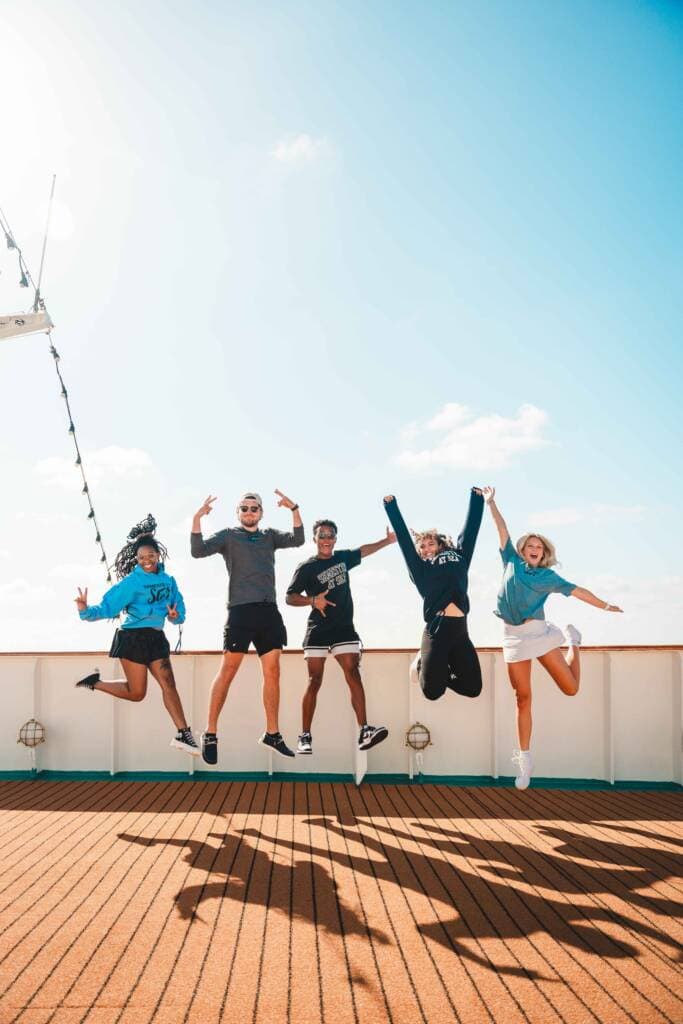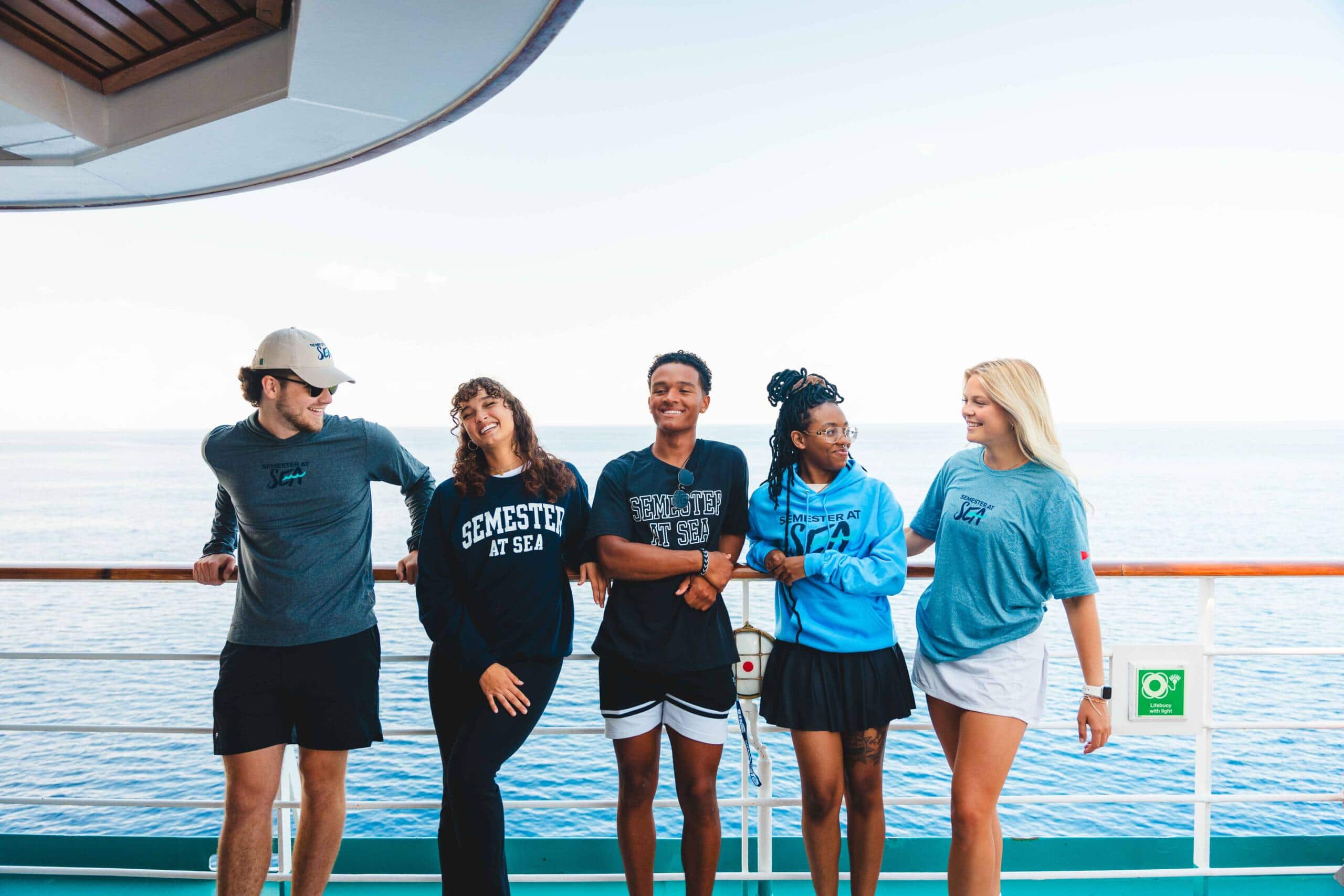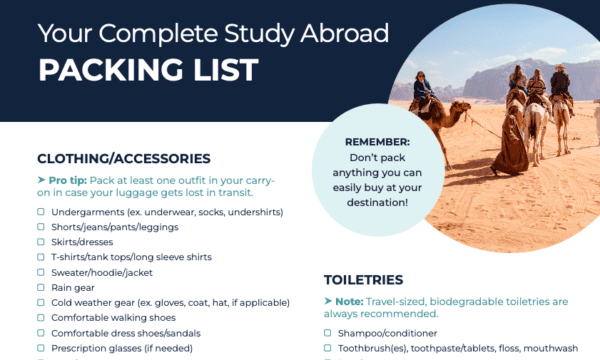You’ve applied and been accepted to your dream study abroad program. You’ve gathered all the necessary documents, secured your accommodations, planned out your itinerary, and made note of all the must-see attractions to catch during your downtime. Now it’s time to pack!
For some, packing is an exciting reminder that the trip you’ve waited so long to take is finally happening; for others, it’s a dreaded chore that stands in the way of the real fun. With the proper planning and helpful organizational tools, even the most daunting packing task can feel manageable (and even a little fun).
To help you pack like a pro, we’ve built the ultimate study abroad packing list that covers all the essentials, the nice-to-haves, and the items you might not think of at first, but that will turn out to be lifesavers overseas. We also offer some expert tips and considerations to help you streamline your luggage, think sustainably, and leave space for special souvenirs.
Things to Remember As You Pack

When you’re planning a big trip, do you start by drafting a comprehensive list and filling a suitcase three months in advance? Or are you more likely to toss some essential outfits and toiletries in a bag at the last minute, figuring you’ll be able to purchase anything you forgot in your destination? No matter what type of packer you are, there are a range of important factors to consider that will inform the size and contents of your luggage.
- Timing: Whatever you do, don’t leave packing until the last minute! Even if you consider yourself “low-maintenance” and typically pack light, a semester abroad is usually a major travel undertaking that requires more than a change of outfits and a camera. Overseas travel, especially, requires extra documents, different kinds of appliances, safety accessories, and potentially special kinds of clothing. You need time to gather all these important and unique items, so start creating and examining your checklist at least a couple weeks before your departure date (and pay special attention to deadlines or lead times for visas, vaccination cards, passports, insurance applications, and other important travel documents).
- Length of stay: How long will you be traveling? Will you have access to laundry facilities? Be sure to pack enough clothing, medications, and toiletries for your trip, but avoid packing too much of anything you can easily purchase in your destination (and factor these expenses into your budget). Items such as toothpaste, deodorant, and even undergarments are readily available in most locales with pharmacies or department stores, but you absolutely want to bring enough of the things you can’t replace or replenish, such as prescription medications. The type of travel matters here as well; you will likely need a few more changes of practical clothes for a semester aboard a research vessel, for example, as opposed to a semester in Paris or London.
- Weather/time of year: Pack clothes and shoes that are appropriate for the weather in your destination. Avoid packing anything out-of-season, such as thick sweaters for a warm climate; even if you think there’s a chance the weather may change, you may be able to purchase what you need once there. Prioritize comfort and lightweight fabrics you can layer over anything strictly stylish or overly formal. Use smaller accessories such as scarves or hats to “dress up” a casual outfit. If you plan to carry extra outfits in case of rain or any other unexpected event, make sure they are light and packable (as in, easy to compress).
- Baggage limit: Depending on the type of program, you may be limited in the number of bags you can bring; regardless, be sure to note the weight and size limits for any forms of transit you’ll be taking. Check TSA requirements and restrictions before boarding any flights. When packing, remember to leave room for any souvenirs you may want to bring home! Use vacuum bags for your clothes to take up as little room as possible.
- Types of luggage: Similarly, there may be restrictions on the types of luggage you may bring. Are hard-sided suitcases permitted, or will you need soft-sided bags? Wheels or no wheels? When in doubt, confirm with the program staff.
- Labels: Label all your luggage with your name and contact info in case it gets lost or misplaced. Speaking of lost — if you can, avoid bringing anything especially valuable or sentimental that you can live without, at least for the length of your stay. If you can’t bear the thought of losing a certain item, leave it at home.
- Important documents: Make copies — both paper and digital — of every important document you need to submit or carry with you for your travels. Documents will vary depending on your destination or the type of program, but usually include your passport, travel or health insurance cards, visas, and proof of program acceptance or financial aid.
- Bedding and linens: You may be required to bring your own bedding if you’ll be staying in a shared dorm or bunk. If possible, wait to purchase bedding until you reach your destination, since sheets and blankets will take up valuable room in your luggage.
- Outlet converters: Electrical appliances vary from country to country, both in terms of voltage and the shape of the plugs and outlets. Some U.S. appliances will not work or will short-circuit if plugged into an outlet overseas without an adaptor. Research the standard voltage and types of plugs in your destination and purchase the appropriate converters. If you need to bring a specific appliance, such as a curling iron, avoid the need for converters and wait to purchase a relatively inexpensive one until you arrive.
- Recreational items: This is a broad category that can include athletic gear, games, musical instruments, and other items that are simply “nice to have.” It’s another story if your program requires you to bring a certain type of recreational item, but if not, it’s best to save the extra room in your luggage.
One final consideration that may affect your packing choices has to do with the cultural expectations in the country or region to which you’re traveling. Some regions are much more conservative than others, which implies that you should leave any clothing that could be considered outlandish or inappropriate at home. Other countries may have differing requirements or customs for everyday activities, such as removing shoes when indoors or sitting on the floor to eat, both of which may impact your clothing choices. Do your research or check with program staff ahead of time to get a better idea for social expectations so you can pack accordingly.
Sample Packing List for Study Abroad Trips
Use the following checklist to ensure you pack all the essentials for travel. Of course, this list is not comprehensive, and you should absolutely consult your program’s suggested packing list so you don’t leave out anything important.
We’ve also provided this checklist in a downloadable form, so you can print out your own copy and cross items off as you pack.
CLOTHING/ACCESSORIES
Pro tip: Pack at least one outfit in your carry-on in case your luggage gets lost in transit.

- Undergarments (ex. underwear, socks, undershirts)
- Shorts/jeans/pants/leggings
- Skirts/dresses
- T-shirts/tank tops/long sleeve shirts
- Sweater/hoodie/jacket
- Rain gear
- Cold weather gear (ex. gloves, coat, hat, if applicable)
- Comfortable walking shoes
- Comfortable dress shoes/sandals
- Sunglasses
- Hat(s)/visor(s)/headscarf(s)
- Swimwear
- Formal/professional wear (if needed)
- Pajamas
- Jewelry staples (nothing too valuable)
- Workout clothes
TOILETRIES
Travel-sized, biodegradable toiletries are always recommended.
- Shampoo/conditioner
- Toothbrush(es), toothpaste/tablets, floss, mouthwash
- Deodorant
- Makeup
- Skincare
- Bar soap/body wash/face wash
- Washcloths/loofah/shower pouf
- Comb/brush/hair products
- Contact lenses and/or prescription eyeglasses
- Personal hygiene products
- Razor(s), non-aerosol shaving cream/gel
- Laundry bag and travel-sized detergent
- Nail clippers and file
- Tweezers
- Dryer sheets to keep clothes fresh in luggage
- Lip balm
ELECTRONICS
Some items are optional. Remember that outlets and voltage differ between countries!

- Plug adapter and/or converter
- Cell phone and charger
- Travel alarm clock/watch
- Camera and charger
- Extra memory cards/batteries
- USB drive/external hard drive
- Selfie stick/GoPro
- E-reader
- Headphones
- Small flashlight and batteries
- Laptop/tablet (with additional battery/charger) and install/recovery programs for all software and operating systems
- Portable power bank
SCHOOL SUPPLIES
The need for these items depends on the type of program. You may not need to bring your own supplies.

- Pens and pencils
- Notebooks, sticky notes, journals, etc.
- Clipboard/lap desk
IMPORTANT DOCUMENTS
Make copies of important documents. Not all items on this list may apply.
- Passport (and extra copies of passport photo page)
- Applicable vaccine records (ex. COVID 19, yellow fever)
- Printed copy of student visa
- Copy of your birth certificate
- Local and international driver’s license
- University enrollment confirmation, acceptance letter, or program verification
- Housing contract
- University transcripts
- Electronic Travel Authorization (if required)
- Proof of medical and travel insurance
- Embassy / consulate phone numbers and/or email
- List of emergency contacts
- Health records: copy of medical records, vaccination certificates
- Travel itinerary details: flight tickets, arrival hotel (if staying in one)
- Bank statements (if required to show proof of funds)
MEDICAL/HEALTH SUPPLIES
Check that prescription medications are legal in your destination country. Keep all medications in their original containers complete with your name and prescription information.
- Prescription medications (enough for your stay)
- Non-prescription pain relievers (ex. Advil, Tylenol)
- Sleep aids (ex. Tylenol PM, ear plugs)
- Allergy medication (ex. Benadryl, Allegra)
- Diarrhea/heartburn medication (ex. Pepto-Bismol, etc.)
- Hand sanitizer/wet wipes
- Sunscreen
- Insect repellent (liquid or wipes)
- Small personal first-aid kit
- N95 face masks
MISCELLANEOUS
Each study abroad experience is different — your miscellaneous items will vary!

- Credit/debit cards/cash in local currency (about $300)
- Purse/wallet
- Reusable water bottle and straw
- Travel mug/utensils
- Backpack/bookbag/daypack
- Microfiber or quick-dry hand towel
- Gifts for homestay hosts
- Business/contact cards
- Quart-sized plastic bags or shopping bags
- Small padlock
- Non-electronic activities and games
- Tissues/toilet paper (you never know!)
- Travel umbrella
- Travel pillow
- Gum/mints
- Lint roller
- Portable stain remover/wrinkle release spray
- An open mind and a sense of adventure!
Items to Leave Behind

There are a handful of items to leave out of your luggage, whether because they will add unnecessary weight, take up too much space, or prove to be unnecessary when you reach your study abroad destination.
Generally, you should leave the following at home:
- Heavy liquids, such as full-sized fabric refresher spray
- Excessive food or snacks
- Full-sized toiletries
- Full-sized aerosol cans
- Heavy books
- Many electronics or electrical appliances
- Bedding (unless necessary)
- Heavy jewelry
- Valuables and luxury items
- Anything culturally inappropriate or illegal
- Hangers
- Clothes you don’t wear at home
- Seasonally inappropriate footwear or outerwear
Your program may have further packing restrictions. Be sure to double-check the program’s packing list to avoid bringing prohibited items.
Tips to Streamline Your Luggage

There are many ingenious packing tips out there to conserve space in your luggage, from compact folding techniques to using footwear as storage. Here are a few that will help you pack lighter and even save resources in the process:
- Only pack travel-sized toiletries that will last until you reach your destination. Bring trial versions of your hair care supplies, toothpaste, mouthwash, and deodorant, usually available in your local supermarket or pharmacy. If you can go a day or so without conditioning your hair, pack a combination shampoo-body wash to reduce the number of travel-sized bottles even further.
- Consider dry or powder alternatives to your usual hair- and skincare products: powdered dry shampoo instead of spray, shampoo bars instead of liquid shampoo, bars of soap instead of body wash, and toothpaste tablets instead of tube toothpaste. If you do pack liquids, seal them in leak-proof bags to protect the rest of your luggage.
- There are reusable versions of nearly every standard toiletry item, including silicone ear swabs, makeup remover remover pads, tissues, and menstrual cups. If you’d rather not re-use toiletries, opt for recyclable instead of plastic or single-use products.
- A microfiber towel is an invaluable accessory to have on the road. These quick-drying towels come in a wide range of sizes and pack down to fit in a corner of your luggage.
- Use packing hacks such as compact packing cubes, vacuum bags, or rolling your clothes rather than folding them. Put smaller items such as socks and beanie hats inside your shoes (wrap them in plastic newspaper or shopping bags if desired, which can then double as dirty clothes bags!).
- If you need help packing light, start with a smaller bag or suitcase that will limit the amount of items you can physically pack.
- Build your outfits around lightweight, easy-to-clean, versatile pieces you can mix and match. If you know you will be without laundry facilities for a time, favor darker pieces that won’t show stains as much and slip dryer sheets between packed clothes to keep them fresh.
- If it’s feasible, wear your bulkier clothes on travel days, such as coats, boots, and jeans to lighten and save space in your luggage.
- If you’ll be responsible for transporting your luggage to your destination (as opposed to the program handling it), don’t pack more than what you’re able to carry for several miles. Unexpected delays or detours can happen to anyone, which means you may be carrying your own luggage around for longer than you initially expected (but hopefully not!).
- Once you think you’re finished packing the first time, take everything out of your bag (yes!) and pack it again. This will help you identify items you can probably leave behind; this is another reason to start your packing process early!
Getting accepted into a study abroad program is a very exciting event, signaling the start of an adventure that will likely be a highlight of your college career. There are many logistics to take care of before you reach your destination, including packing, but with plenty of preparation and organization, you can confidently embark on this experience with everything you need to succeed and make lasting memories.





